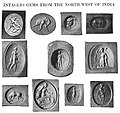File:Intaglio gems from the northwest of India.jpg

Original file (1,700 × 1,604 pixels, file size: 1 MB, MIME type: image/jpeg)
| This is a file from the Wikimedia Commons. Information from its description page there is shown below. Commons is a freely licensed media file repository. You can help. |
Summary
| DescriptionIntaglio gems from the northwest of India.jpg |
English: Imprints of intaglio gems from the northwest of India. "The engraved gems referred to are found in large numbers throughout the whole north-western area and are proved by the presence of legends in early Brahmi or Kharoshthi, as well as in Greek characters, to be the work of resident artists. Some typical specimens are illustrated in PL XXXIII, 88, a-k. The first is a cornelian intaglio from Akra in the Bannu district, of pure Hellenistic workmanship, designed and executed with a fine sense of composition and relief. Judging by the persistency with which it was repeated, the motif of the fighting warriors on this gem must have been almost as favourite a one in India as it was in Greece. Next to it and of about the same date is a remarkably spirited elephant cut on a pale sard. Then comes a jacinth (c), the jugate heads on which recall to mind the busts of Heliocles and Laodice on coins of Eucratides, though it is slightly later than they. The lion, also, on pale sard (d) is a fine example of delicate technique ; but in fig. e — a singularly beautiful sardoine — the style shows incipient signs of falling off", and in the three following specimens, a black garnet and two sards, we watch its slow and sure deterioration until the beginning of the Christian era. The next two gems of the series (i and j) are still more decadent. The treatment of the drapery and other details of the seated Athena in the former remind us irresistibly of coins struck about the time of Hermaeus, and we cannot be far wrong in assigning this gem to about 50 A.D., and the one which follows it to the close of the same century. The latter is a cornelian from the Hazara District, engraved with a figure of Aphrodite and bearing a legend in corrupt Greek characters. Finally, in fig. h, we have a representative of a large group of gems executed in a meretricious and distinctive style, which appears to have been fashionable in India in the first and second centuries A.D. and which, taken in conjunction with other facts, suggests that a strong wave of influence — due, perhaps, to Roman expansion — set in about that time from Asia Minor." From Cambridge History of India (Public Domain) |
| Date | |
| Source | The Cambridge history of India 1922 [1] |
| Author | The Cambridge history of India 1922 |
Licensing
| Public domainPublic domainfalsefalse |
This work is in the public domain in the United States because it was published (or registered with the U.S. Copyright Office) before January 1, 1929.
Public domain works must be out of copyright in both the United States and in the source country of the work in order to be hosted on the Commons. If the work is not a U.S. work, the file must have an additional copyright tag indicating the copyright status in the source country.
Note: This tag should not be used for sound recordings.PD-1923Public domain in the United States//commons.wikimedia.org/wiki/File:Intaglio_gems_from_the_northwest_of_India.jpg |
| Public domainPublic domainfalsefalse |
This work is in the public domain in India because its term of copyright has expired.
The Indian Copyright Act applies in India to works first published in India. According to the Indian Copyright Act, 1957, as amended up to Act No. 27 of 2012 (Chapter V, Section 25):
العربيَّة | বাংলা | Deutsch | English | français | हिन्दी | italiano | 日本語 | ಕನ್ನಡ | македонски | മലയാളം | मराठी | Nederlands | português do Brasil | sicilianu | தமிழ் | ತುಳು | اردو | 繁體中文 | +/− |
 |
Captions
Items portrayed in this file
depicts
1 January 1922Gregorian
image/jpeg
File history
Click on a date/time to view the file as it appeared at that time.
| Date/Time | Thumbnail | Dimensions | User | Comment | |
|---|---|---|---|---|---|
| current | 07:26, 2 September 2018 |  | 1,700 × 1,604 (1 MB) | पाटलिपुत्र | User created page with UploadWizard |
File usage
Metadata
This file contains additional information, probably added from the digital camera or scanner used to create or digitize it.
If the file has been modified from its original state, some details may not fully reflect the modified file.
| Width | 1,700 px |
|---|---|
| Height | 1,604 px |
| Horizontal resolution | 72 dpi |
| Vertical resolution | 72 dpi |
| Software used | PaintShop Pro 20,00 |
